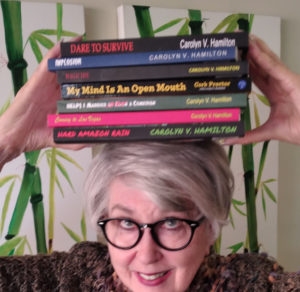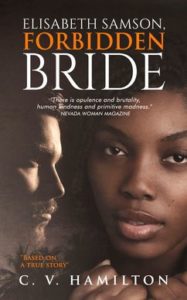Multi-genre writer RPCV Carolyn V. Hamilton (Suriname)
Welcome to BookView Interview, a conversation series where BookView talks to authors.
Recently, we interviewed Carolyn V. Hamilton Proctor (Suriname 1999-01) a multi-genre author, with books published in mystery, romance, memoir, and non-fiction as well as adult coloring books about her writing, and recently released, Elisabeth Samson, Forbidden Bride, a poignant and powerful historical drama.

Carolyn V. Hamilton Proctor
Born and raised in Seattle, Washington, and a graduate of Antioch University Seattle, she spent over 30 years in the real world of “Mad Men.” She is also a Success Coach for memoir writers, and manages the FB group, Aspiring Memoir Writers.
She currently lives way up in the Andes in the World Heritage City of Cuenca, Ecuador. Besides writing and mentoring, Border Collies, chocolate-covered raisins, art journaling and painting in watercolor are favorite activities.
Carolyn V. Hamilton is proud to have served 2 years in the Peace Corps (which inspired her first novel) and, oh yes…she was once a Playboy Bunny.
•
How often do you base your characters on real people?
Almost all of the characters in my novels have been inspired by people I’ve met or known at some point. Most of them will never read my books, and I doubt they would recognize themselves. Some of my characters are composite sketches.
What kind of research do you do, and how long do you spend researching before beginning a book?
Sometimes I interview people, and almost any question can be googled. I read books for background and supporting information. I was blessed to have the magician’s magician, Johnny Thompson (“The Great Tomsoni”) as a mentor when I wrote Magicide. I also spent 12 weeks in Las Vegas’ Citizen’s Police Academy to learn how Metro operated. Time spent researching depends on how well I know my characters, subject matter, and environment before I begin to write.
What’s the most difficult thing about writing a novel?
For me, I don’t think it’s difficult at all. Like anything else, one should study the greats, know well one’s chosen genre, and keep reading. But I know other writers who struggle with different aspects of the process. For some, the challenge is story flow, for others it can be writing dialogue, or editing. It tends to depend on the individual writer.
Does writing energize or exhaust you?
Writing, once I get my butt in the chair, energizes me. I think it’s important to feel good about and enjoy the writing process, even when it’s difficult.
Do you read your book reviews? Do they please you or annoy you? Do you think you can learn a lot from reading criticism about your work?
I love reviews, good and bad. They often tell me more about the reviewer than about my writing and story-telling! I also write a lot of book reviews. I’ve found writers’ groups to be immensely helpful in terms of constructive feedback.
Who and what ultimately inspired you to become a writer?
In high school in the sixties I had an amazing creative writing teacher, Virginia Dearborn. I loved her class so much I took it twice! Because I had artistic talent and at the time wanted to be a fashion illustrator, I never saw myself as a future author. Over the years I wrote a few short stories and a lot of advertising copy, but it would be four decades before I wrote my first novel. Now I’m hooked.
Is writer’s block real?
Yes, in the same sense that procrastination is real. We have to just get in there, start with a baby step, and do it!
What authors do you like to read? What book or books have had a strong influence on you or your writing?
Carl Hiassen, Barbara Kingsolver, and Barbara Tuchman are my top favorites. I especially appreciate the way Barbara Tuchman can take a subject as reputedly boring as history, bring the characters alive — warts and all — and make real events become almost like a movie-of-the-week. Currently I am reading more memoirs.
QUESTIONS ABOUT YOUR BOOK
What inspired the premise of your book? Tell us a little about how this story first came to be. Did it start with an image, a voice, a concept, a dilemma or something else? Where do your ideas for this story come from?
 Elisabeth Samson, Forbidden Bride is based on the true story of the first black woman in the South American/Dutch plantation colony of Suriname to gain legal permission from the government to marry a white man. Dutch laws of the time catagorized people by their percentage of black or Amerindian blood. Marriage between a one hundred percent white person and a one hundred percent black person was strictly forbidden.
Elisabeth Samson, Forbidden Bride is based on the true story of the first black woman in the South American/Dutch plantation colony of Suriname to gain legal permission from the government to marry a white man. Dutch laws of the time catagorized people by their percentage of black or Amerindian blood. Marriage between a one hundred percent white person and a one hundred percent black person was strictly forbidden.
At the time I became aware of Elisabeth Samson’s story, I was living in Suriname serving two years as a Peace Corps volunteer. I have always been a voracious reader, but had never before written a novel.
Are any of your characters based on real people you know?
Ninety-five percent of the characters in the book were real people who lived, loved, played, worked, and fought in 18th century Suriname, at the time the richest country in South America.
Which scene, character or plotline changed the most from first draft to published book?
At the time I got the idea to write Elisabeth Samson, Forbidden Bride, I was enamored with the romance genre. I thought her story would make a great romance novel. But as I delved more into her history and research, I realized Elisabeth’s story was far more serious and needed to be told in a more literary style. So what started out in my head as a romance became historical fiction.
What makes this book important right now?
In the United States there’s a current obsession with the history of slavery and race relations. Elisabeth Samson, Forbidden Bride presents a look at slavery in the 18th century that involved countries other than the United States. It’s also a woman’s story, a story of the first black woman in Suriname to fight for — and receive — legal permission from a Dutch government to marry a white man. I hope readers will take away a broader understanding of the history of slavery in the western world.
What sort of a relationship exists between you and the characters you created in this book?
When I first planned to write Elisabeth Samson, Forbidden Bride I planned to write it in third person. As I became more heavily involved in research that included 18th century journals and plantation records, I became compelled to tell the story in first person. Perhaps because I had lived in Suriname, walked the streets Elisabeth Samson walked, visited her house in Paramaribo and ate the foods she would have eaten, I began to feel almost as if she were standing over my shoulder, dictating her story. It became strangely eerie. Afterwards I anticipated that readers might question how I could write as a white woman in first person for a black woman, but the question never arose. I suspect it’s because strong feelings of love, desire, anger and family are universal.
What’s more important: characters or plot?
Definitely characters. We never forget compelling characters. Scarlet O’Hara comes to mind. As readers we love characters we can identify with, especially if that character experiences strong emotions.
How many unpublished and half-finished books do you have?
Right now I have a non-fiction book for memoir writers, a series of joke books, and my third adult coloring book — my first in grayscale. I’m on target to complete and publish them in the next 90 days.
What’s next for you?
I have an idea for a female investigator mystery series. I’ve got books titles, character names and rough outlines. Several years ago I actually interviewed an investigator after whom I’d like to model my heroine. Because I have some other projects I want to finish and get off my laptop first, I don’t see myself seriously sitting down to begin it until January of 2022.
Thank you!
•
Check out Carolyn’s website: www.carolynvhamilton.com
 Elisabeth Samson, Forbidden Bride
Elisabeth Samson, Forbidden Bride
C.V. Hamilton (Suriname 1999-01)
Swift House Press
June 2020
401 pages
$17.95 (paperback), $3.99 (Kindle)
No comments yet.
Add your comment